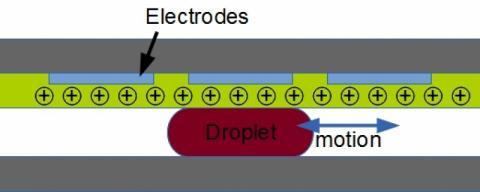
Researchers at the Indian Institute of Science (IISc) have designed a new type of energy harvester that can scavenge electrical energy from weak vibrations. Vibration drives a liquid droplet and the motion of the liquid droplet produces electrical energy which can power portable electronic devices efficiently.
Conventional sources of energy are precious and they are getting exhausted at a very rapid pace. Scientists are looking for alternative sources of energy, like solar energy, wind energy, energy from bio waste etc., to replace the conventional sources. “Energy harvesting” is the conversion of unusual forms of energy, like heat, wind, vibration etc., which are otherwise wasted, into some usable form of energy. Efficient energy harvesting is the key to addressing our ever-increasing energy problem.
In the past, a considerable effort has been made to produce electrical energy from vibrations. These were based on piezoelectricity, electromagnetism, and electrostatics. However, all these methods suffered from low efficiency or required an initial driving force. The research team from Center for Nano Science & Engineering at IISc, lead by Prof. Prosenjit Sen, has successfully demonstrated an energy harvester which takes advantage of liquid motion on a carefully designed surface to efficiently generate electrical energy. “The device can be efficiently used if it is connected with an object which has oscillatory feeble vibration. The vibration drives the droplet. The motion of the droplet is used to extract electrical energy which can be used to power portable devices”, says Prof. Sen.
Using well-established micro- and nano-fabrication techniques, the team has fabricated a surface with areas that selectively like or dislike a mercury droplet. Another surface, placed on top, has the electrodes and is pre-charged to provide a permanent source of electric field. As the mercury droplet slides between the two surfaces, it acts like a battery and powers any device connected between the two surfaces. The sliding of mercury is controlled by the vibration of the device. Thus, the device acts like a portable battery which is a self-sustaining, inexhaustible source of energy.
The bottom plate is carefully designed such that the interfacial loss is reduced and the droplet can easily slide across the surface. This makes the device more efficient compared to other microfluidic devices which suffer heavy losses due to the liquid droplet sticking to the surface. The device is capable of generating a voltage as high as 2V and can operate under weak vibration. “We propose to achieve high efficiency in droplet based devices. These devices are significantly simpler to fabricate compared to conventional cantilever based designs. These devices are also expected to have better harvesting efficiency compared other devices”, says Prof. Sen while discussing the tremendous potential of the device.
About the Author:
Prosenjit Sen is an assistant professor at the Centre for Nano Science & Engineering, Indian Institute of Science, Bangalore. http://www.cense.iisc.ernet.in/people/faculty/prosen.htm
